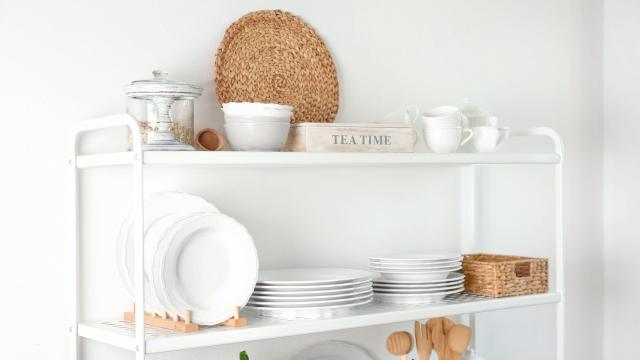Whether it’s from too many items of sentimental value or you just haven’t thrown things out in a while, decluttering can be hard. When a kitchen gets cluttered, though, it can be even worse than a crowded closet or garage because it starts to affect the functionality of a space you use multiple times a day.
We all have that junk drawer full of sauce packets and menus, but our kitchens can evolve a little closer to being a carefully curated space that makes our everyday lives a little easier. The “one shelf method” is one way to begin decluttering your kitchen and optimising your cooking space.
How to declutter your kitchen with the one shelf method
Open cabinets or open-concept storage is a way to keep your glassware and ceramics easily accessible, and open shelving also means your dishes are on display. If you have too many cups, though, it’s going to make your shelves look disorganized and pretty messy. Lifestyle writer Shifrah Combiths with Apartment Therapy uses the “one shelf method” of organising her kitchen. The method combines a Marie Kondo method with some minimalist ideals.
You start by taking all of the things you have an abundance of, whether that’s plates, glassware, or, in Combiths case, mugs, and keep only what you can store on one shelf. She suggests starting with the things that mean the most to you. Then, once the shelf is full, you stop.
The hardest part is keeping yourself from stacking items just to hold onto them, but try to keep only what you use or absolutely love. If you have the champagne flutes from your cousin’s wedding that you never use, odds are they’re just taking up space.
How to sort your kitchen’s overflow items
Sentimental value is a big part of how a kitchen gets cluttered, but it’s not the only part, as it’s easy to accumulate kitchen supplies we think will be helpful but then end up in the junk drawer. Organisation site Clean & Scentsible offers four good questions to ask yourself when decluttering a space:
- Do I use this?
- Is this item extra?
- Would I buy this today?
- Does this help to make my life easier?
The Project Neat adds the question, “Have I used this more than once this month?” Basically, if you find yourself making excuses to keep something, it’s probably a sign you can get rid of it.
How to prevent future kitchen clutter
Once you disposed of everything you don’t need, clean the space and reorganise your shelves and drawers. The Project Neat has a handy checklist that will help you through the declutter process:
- Gather cleaning supplies.
- Clean one area at a time: remove everything and wipe down inside.
- Separate all items into piles: Keep. Trash. Donate. Recycle.
- Make sure you have at least one working item of each kitchen essential.
- Organise cabinets, drawers, and counters.
- Return items to newer, organised areas.
When reorganising, buy clear bins and baskets to store items so they’re visible, and use drawer organisers for easy access. That’ll help prevent future clutter and make your next kitchen purge that much easier.

Leave a Reply
You must be logged in to post a comment.